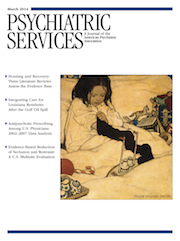Caregiver Depression Screening in a Specialty Mental Health Clinic
Many children receiving mental health services have parents who suffer from depression. Prevalence of depressive disorders among parents of children brought for evaluation in child specialty mental health clinics is two to three times higher than national averages, and yet rates of treatment seeking are very low. Parental depression constitutes an important risk factor for childhood psychiatric illness, poor child treatment outcomes, and higher child-related mental health service expenditures. Despite the public health importance of this problem, routine screening for parental depression is rarely conducted in child mental health settings.
This report describes implementation of caregiver depression screening and treatment referral in a child mental health clinic that serves youths ages four to 18. All procedures were approved by the University of Pittsburgh Medical Center Quality Improvement Review Board. Caregivers (parents, foster parents, grandparents, and nonrelated legal guardians) were screened with the nine-item Patient Health Questionnaire (PHQ-9), a self-report measure of depressive symptoms. Total scores range from 0 to 27 (higher scores indicate more depressive symptoms). Children’s demographic data were extracted from clinical records.
Clerical staff placed copies of the PHQ-9 in intake paperwork packets. Letters invited caregivers to complete the form but specified that participation was voluntary. Completed forms were returned to intake clinicians, who scored them and provided feedback. If scores were ≥8, clinicians offered referrals for mental health services using an adult referral list that sorted treatment options by location, insurance accepted, and type of treatment provided. Clinicians recorded whether or not referrals were accepted.
Safety procedures were developed to address concerns about detection of occult suicidality. If caregivers endorsed a 1, 2, or 3 on the suicidal ideation item of the PHQ-9 (corresponding to “several days,” “more than half the days,” and “nearly every day”), clinicians probed further. If threat appeared imminent, clinicians sought emergency services for the caregiver. If clinicians did not detect imminent threat, caregivers were either referred to their own treatment team (if already in care) or “fast tracked” to a scheduled appointment at a local adult mental health clinic. Although this was a large concern prior to implementation of screening, these procedures were never implemented because of absence of high levels of suicidality among caregivers.
Between June 1, 2010, and May 31, 2012, a total of 1,274 youths were seen for an initial psychiatric evaluation. The mean±SD age of children was 11.7±3.7 years. Approximately half (55%; 701 of 1,270) were boys, and 60% were white (767 of 1,274). The most common primary clinical diagnoses were attention-deficit hyperactivity disorder (30%; 381 of 1,274) and adjustment disorders (24%; 299 of 1,274). Payer mix was evenly divided between commercial insurance and medical assistance. Forty-six percent (581 of 1,274) of caregivers completed the PHQ-9. Most were female (89%; 438 of 492) and white (68%; 329 of 483). Caregiver age was 40.0±8.59 years. The mean PHQ-9 score was 7.00±5.95 (range 0–25). Twelve percent (67 of 581) of caregivers endorsed the suicide item of the PHQ-9 at the level of 1 (“several days”) or higher.
Of 581 caregivers screened, 233 (40%) scored ≥8 on the PHQ-9. Of those, 45% (106 of 233) accepted referrals for mental health services; 12% (28 of 233) declined referrals, indicating that they were already receiving psychiatric treatment; 16% (38 of 233) were deemed by the child clinician not to require referrals; <1% (1 of 233) requested more information, and 25% (58 of 233) declined referrals. There was no difference in mean PHQ-9 score between those deemed by the clinician not to require a referral and those who accepted a referral. Those who accepted a referral had significantly higher PHQ-9 scores than those who declined a referral (14.5±4.0 versus 10.9±2.9, respectively; p<.001). There were no significant differences in age, gender, or race-ethnicity between those who accepted and those who declined a referral. With a more conventional threshold of PHQ-9 score ≥10 (corresponding to moderate depression), 31% (182 of 581) would have been identified as having elevated depression scores.
Most caregivers experienced the depression screening process as supportive. Anecdotally, many families expressed appreciation for the clinic’s willingness to address caregiver needs in addition to those of their offspring. Although caregivers who accepted mental health referrals represent only 8% (106 of 1,274) of total intakes during the performance period, this translates to approximately one caregiver per week referred for mental health services who likely otherwise would not have been identified. Although depressed caregivers of psychiatrically ill children are unlikely to access mental health services for themselves, many will seek care for their children. Thus settings in which children receive mental health services may constitute important locations in which to identify—and potentially treat—depressed caregivers. Future studies should examine the impact of such initiatives on child outcomes.



